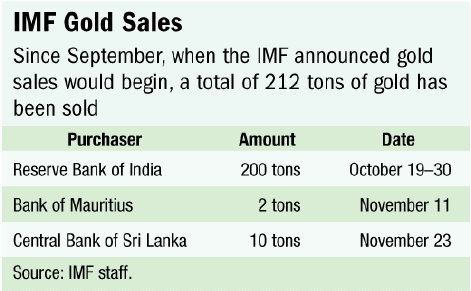
Typical street scene in Santa Ana, El Salvador. (Photo: iStock)
IMF Survey: IMF ‘On-Market’ Gold Sales Move Ahead
February 17, 2010
- IMF will sell gold on the gold market
- Future sales to continue in transparent manner
- Avoiding market disruption is top priority
Following the sale of 212 tons of gold to central banks, the IMF is moving ahead with sales on the gold market, phasing the sales so as to avoid market disruption.

The IMF announced last year its intentions to sell just over 403 metric tons of gold, and official interest in the IMF’s gold sales has proven substantial (Photo: Newscom)
IMF income and expenditure
In September 2009, the IMF’s Executive Board approved gold sales totaling 403.3 metric tons (12,965,649 troy ounces). Having already sold over half that amount to several central banks, the IMF is now looking to sell the remaining 191.3 tons of gold.
The IMF will continue to hold a substantial portion of its assets in gold. The sale of the full 403.3 metric tons would reduce the IMF’s gold holdings by about one-eighth.
“The top priority in conducting the gold sales is to avoid disruption to the gold market,” said Andrew Tweedie, Director of the IMF’s Finance Department. “Prior to any sales on the gold market, sales were first made exclusively to interested central banks, thus shifting gold within the official sector. Now the IMF will begin sales of the remaining gold on the market. This will be done in a phased way.”
Sales to date
Official interest in the IMF’s gold sales has proven substantial—at 212 tons thus far. The proceeds from these sales amount to almost $7.2 billion, or just over SDR 4.5 billion. The sales were conducted at market prices, and were allocated on a first-come, first-served basis to three central banks that expressed interest.
While the period set aside exclusively for official sales is now over, the IMF remains ready to respond to interest in gold from official holders.

Largest gold sale in decades
The 200-ton sale to the Reserve Bank of India is considered by some market commentators to be the single largest gold transaction in recent decades, generating proceeds equivalent to $6.7 billion or SDR 4.2 billion.
In light of the volume involved, daily sales for the transaction took place over a two-week period from October 19–30, 2009, to protect both parties against short-term fluctuations in gold prices. Each daily sale was conducted on the basis of market prices prevailing that day.
Sales of gold to the Bank of Mauritius and the Central Bank of Sri Lanka were each conducted on a single day, November 11 and 23 respectively.
Purposes of IMF gold sales
Gold sales, strictly limited to 403.3 tons, were approved by the IMF’s Executive Board on September 18, 2009, and will serve two purposes.
Key to new income model: The IMF’s new income model is based on the recommendations of the Committee of Eminent Persons chaired by Andrew Crockett to reduce the Fund’s reliance on lending income to cover its administrative expenses. The new income model aims to diversify the IMF’s income sources and better align them with the variety of functions performed by the Fund. A key element is the creation of an endowment with the profits from gold sales, which would be invested in a manner consistent with the public nature of these funds.
Low-income countries to benefit: In 2009, the IMF agreed to mobilize $17 billion through 2014 for lending to low-income countries, mostly in Africa, that have been hard hit by the global crisis. A financing package, which includes resources linked to these gold sales, has been agreed upon and will generate the additional new subsidy resources of SDR 1.5 billion needed to help cover the cost of further low-interest lending by the Fund.
The sales generated proceeds equivalent to $72 million (SDR 45 million) in the case of the Bank of Mauritius, while the sale to the Central Bank of Sri Lanka generated $375 million (SDR 234 million).
Transparent approach
The IMF publicly announced each official sale shortly after the transaction was concluded. A high degree of transparency will continue during the sales of gold on the market, in order to assure markets that the sales are being conducted in a responsible manner.
As in the case of central banks selling gold, the volume of IMF gold holdings will be reported on a monthly basis through the International Financial Statistics, and the IMF’s quarterly financial statements will provide additional disclosures.
The strategy for the IMF’s sales of gold on the market continues to give priority to avoiding market disruption. As such, the sales will be phased over time following the approach used successfully by the central banks participating in the Central Bank Gold Agreement.


